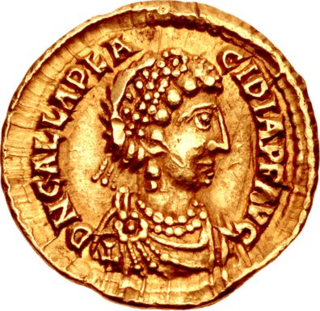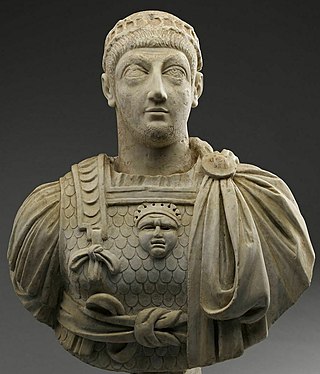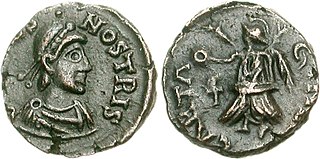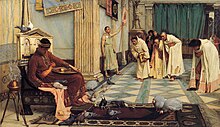
Honorius was Roman emperor from 393 to 423. He was the younger son of emperor Theodosius I and his first wife Aelia Flaccilla. After the death of Theodosius in 395, Honorius, under the regency of Stilicho, ruled the western half of the empire while his brother Arcadius ruled the eastern half. His reign over the Western Roman Empire was notably precarious and chaotic. In 410, Rome was sacked for the first time since the Battle of the Allia almost 800 years prior.

Galla Placidia, daughter of the Roman emperor Theodosius I, was a mother, tutor, and advisor to emperor Valentinian III. She was queen consort to Ataulf, King of the Visigoths from 414 until his death in 415, briefly empress consort to Constantius III in 421, and managed the government administration as a regent during the early reign of Valentinian III until her death.

Pope Boniface I was the bishop of Rome from 28 December 418 to his death on 4 September 422. His election was disputed by the supporters of Eulalius until the dispute was settled by Emperor Honorius. Boniface was active in maintaining church discipline, and he restored certain privileges to the metropolitical sees of Narbonne and Vienne, exempting them from any subjection to the primacy of Arles. He was a contemporary of Augustine of Hippo, who dedicated to him some of his works.

Year 410 (CDX) was a common year starting on Saturday of the Julian calendar. At the time, it was known as the Year after the Consulship of Honorius and Theodosius. The denomination 410 for this year has been used since the early medieval period, when the Anno Domini calendar era became the prevalent method in Europe for naming years.
The 420s decade ran from January 1, 420, to December 31, 429.

Year 418 (CDXVIII) was a common year starting on Tuesday of the Julian calendar. At the time, it was known as the Year of the Consulship of Honorius and Theodosius. The denomination 418 for this year has been used since the early medieval period, when the Anno Domini calendar era became the prevalent method in Europe for naming years.

Year 422 (CDXXII) was a common year starting on Sunday of the Julian calendar. At the time, it was known as the Year of the Consulship of Honorius and Theodosius. The denomination 422 for this year has been used since the early medieval period, when the Anno Domini calendar era became the prevalent method in Europe for naming years.

Year 408 (CDVIII) was a leap year starting on Wednesday of the Julian calendar. At the time, it was known as the Year of the Consulship of Bassus and Philippus. The denomination 408 for this year has been used since the early medieval period, when the Anno Domini calendar era became the prevalent method in Europe for naming years.

Year 393 (CCCXCIII) was a common year starting on Saturday of the Julian calendar. At the time, it was known as the Year of the Consulship of Augustus and Augustus. The denomination 393 for this year has been used since the early medieval period, when the Anno Domini calendar era became the prevalent method in Europe for naming years.
The 390s decade ran from January 1, 390 to December 31, 399
The 410s decade ran from January 1, 410, to December 31, 419.

Year 457 (CDLVII) was a common year starting on Tuesday of the Julian calendar. At the time, it was known as the Year of the Consulship of Constantinus and Rufus. The denomination 457 for this year has been used since the early medieval period, when the Anno Domini calendar era became the prevalent method in Europe for naming years.

Year 384 (CCCLXXXIV) was a leap year starting on Monday of the Julian calendar. At the time, it was known as the Year of the Consulship of Ricomer and Clearchus. The denomination 384 for this year has been used since the early medieval period, when the Anno Domini calendar era became the prevalent method in Europe for giving names to years.

Valentinian III was Roman emperor in the West from 425 to 455. Starting in childhood, his reign over the Roman Empire was one of the longest, but was dominated by civil wars among powerful generals and the invasions of late antiquity's Migration Period.

Stilicho was a military commander in the Roman army who, for a time, became the most powerful man in the Western Roman Empire. He was partly of Vandal origins and married to Serena, the niece of emperor Theodosius I. He became guardian for the underage Honorius. After nine years of struggle against barbarian and Roman enemies, political and military disasters finally allowed his enemies in the court of Honorius to remove him from power. His fall culminated in his arrest and execution in 408.
Antipope Eulalius was antipope from December 418 to April 419. Elected in a dual election with Pope Boniface I, he eventually lost out to Boniface and became bishop of Napete.

Bonifatius was a Roman general and governor of the diocese of Africa. He campaigned against the Visigoths in Gaul and the Vandals in North Africa. An ally of Galla Placidia, mother and advisor of Valentinian III, Bonifacius engaged in Roman civil wars on her behalf against the generals Felix in 427-429 and Aetius in 432. Although he defeated the latter at the Battle of Rimini, Bonifacius suffered a fatal wound and was succeeded by his son-in-law Sebastianus as patricius of the Western Roman Empire.

Saint Telemachus was a monk who, according to the Church historian Theodoret, tried to stop a gladiatorial fight in a Roman amphitheatre, and was stoned to death by the crowd. The Christian Emperor Honorius, however, was impressed by the monk's martyrdom and it spurred him to issue a historic ban on gladiatorial fights. Frederick George Holweck gives the year of his death as 391.

The Theodosian dynasty was a Roman imperial family that produced five Roman emperors during Late Antiquity, reigning over the Roman Empire from 379 to 457. The dynasty's patriarch was Theodosius the Elder, whose son Theodosius the Great was made Roman emperor in 379. Theodosius's two sons both became emperors, while his daughter married Constantius III, producing a daughter that became an empress and a son also became emperor. The dynasty of Theodosius married into, and reigned concurrently with, the ruling Valentinianic dynasty, and was succeeded by the Leonid dynasty with the accession of Leo the Great.
Flavius Castinus held the position of patricius in the court of Roman Emperor Honorius at the time of the Emperor's death, and most likely for some time before. He also served as consul for the year 424.














